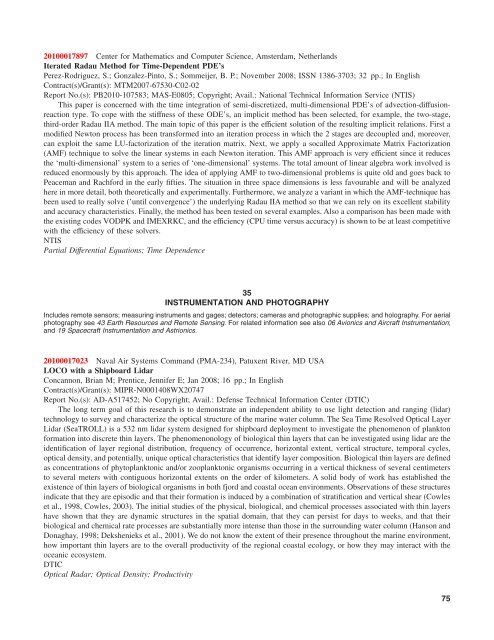NASA Scientific and Technical Aerospace Reports - The University ...
NASA Scientific and Technical Aerospace Reports - The University ...
NASA Scientific and Technical Aerospace Reports - The University ...
Create successful ePaper yourself
Turn your PDF publications into a flip-book with our unique Google optimized e-Paper software.
20100017897 Center for Mathematics <strong>and</strong> Computer Science, Amsterdam, Netherl<strong>and</strong>s<br />
Iterated Radau Method for Time-Dependent PDE’s<br />
Perez-Rodriguez, S.; Gonzalez-Pinto, S.; Sommeijer, B. P.; November 2008; ISSN 1386-3703; 32 pp.; In English<br />
Contract(s)/Grant(s): MTM2007-67530-C02-02<br />
Report No.(s): PB2010-107583; MAS-E0805; Copyright; Avail.: National <strong>Technical</strong> Information Service (NTIS)<br />
This paper is concerned with the time integration of semi-discretized, multi-dimensional PDE’s of advection-diffusionreaction<br />
type. To cope with the stiffness of these ODE’s, an implicit method has been selected, for example, the two-stage,<br />
third-order Radau IIA method. <strong>The</strong> main topic of this paper is the efficient solution of the resulting implicit relations. First a<br />
modified Newton process has been transformed into an iteration process in which the 2 stages are decoupled <strong>and</strong>, moreover,<br />
can exploit the same LU-factorization of the iteration matrix. Next, we apply a socalled Approximate Matrix Factorization<br />
(AMF) technique to solve the linear systems in each Newton iteration. This AMF approach is very efficient since it reduces<br />
the ‘multi-dimensional’ system to a series of ‘one-dimensional’ systems. <strong>The</strong> total amount of linear algebra work involved is<br />
reduced enormously by this approach. <strong>The</strong> idea of applying AMF to two-dimensional problems is quite old <strong>and</strong> goes back to<br />
Peaceman <strong>and</strong> Rachford in the early fifties. <strong>The</strong> situation in three space dimensions is less favourable <strong>and</strong> will be analyzed<br />
here in more detail, both theoretically <strong>and</strong> experimentally. Furthermore, we analyze a variant in which the AMF-technique has<br />
been used to really solve (’until convergence’) the underlying Radau IIA method so that we can rely on its excellent stability<br />
<strong>and</strong> accuracy characteristics. Finally, the method has been tested on several examples. Also a comparison has been made with<br />
the existing codes VODPK <strong>and</strong> IMEXRKC, <strong>and</strong> the efficiency (CPU time versus accuracy) is shown to be at least competitive<br />
with the efficiency of these solvers.<br />
NTIS<br />
Partial Differential Equations; Time Dependence<br />
35<br />
INSTRUMENTATION AND PHOTOGRAPHY<br />
Includes remote sensors; measuring instruments <strong>and</strong> gages; detectors; cameras <strong>and</strong> photographic supplies; <strong>and</strong> holography. For aerial<br />
photography see 43 Earth Resources <strong>and</strong> Remote Sensing. For related information see also 06 Avionics <strong>and</strong> Aircraft Instrumentation;<br />
<strong>and</strong> 19 Spacecraft Instrumentation <strong>and</strong> Astrionics.<br />
20100017023 Naval Air Systems Comm<strong>and</strong> (PMA-234), Patuxent River, MD USA<br />
LOCO with a Shipboard Lidar<br />
Concannon, Brian M; Prentice, Jennifer E; Jan 2008; 16 pp.; In English<br />
Contract(s)/Grant(s): MIPR-N0001408WX20747<br />
Report No.(s): AD-A517452; No Copyright; Avail.: Defense <strong>Technical</strong> Information Center (DTIC)<br />
<strong>The</strong> long term goal of this research is to demonstrate an independent ability to use light detection <strong>and</strong> ranging (lidar)<br />
technology to survey <strong>and</strong> characterize the optical structure of the marine water column. <strong>The</strong> Sea Time Resolved Optical Layer<br />
Lidar (SeaTROLL) is a 532 nm lidar system designed for shipboard deployment to investigate the phenomenon of plankton<br />
formation into discrete thin layers. <strong>The</strong> phenomenonology of biological thin layers that can be investigated using lidar are the<br />
identification of layer regional distribution, frequency of occurrence, horizontal extent, vertical structure, temporal cycles,<br />
optical density, <strong>and</strong> potentially, unique optical characteristics that identify layer composition. Biological thin layers are defined<br />
as concentrations of phytoplanktonic <strong>and</strong>/or zooplanktonic organisms occurring in a vertical thickness of several centimeters<br />
to several meters with contiguous horizontal extents on the order of kilometers. A solid body of work has established the<br />
existence of thin layers of biological organisms in both fjord <strong>and</strong> coastal ocean environments. Observations of these structures<br />
indicate that they are episodic <strong>and</strong> that their formation is induced by a combination of stratification <strong>and</strong> vertical shear (Cowles<br />
et al., 1998, Cowles, 2003). <strong>The</strong> initial studies of the physical, biological, <strong>and</strong> chemical processes associated with thin layers<br />
have shown that they are dynamic structures in the spatial domain, that they can persist for days to weeks, <strong>and</strong> that their<br />
biological <strong>and</strong> chemical rate processes are substantially more intense than those in the surrounding water column (Hanson <strong>and</strong><br />
Donaghay, 1998; Dekshenieks et al., 2001). We do not know the extent of their presence throughout the marine environment,<br />
how important thin layers are to the overall productivity of the regional coastal ecology, or how they may interact with the<br />
oceanic ecosystem.<br />
DTIC<br />
Optical Radar; Optical Density; Productivity<br />
75

















